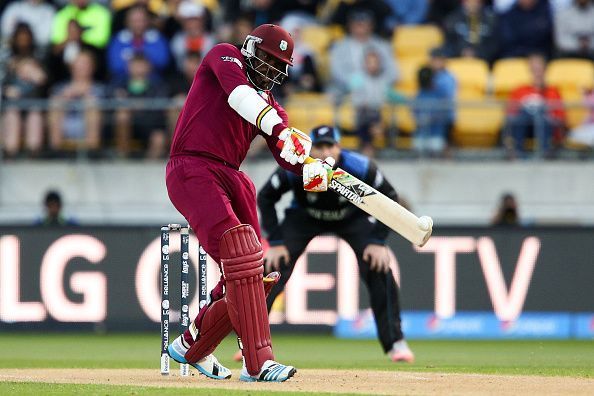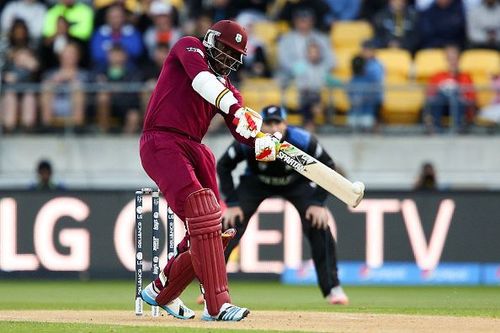
Looking back at the first two World Cup double-centuries, by Chris Gayle and Martin Guptill in 2015

Sometimes, it takes 40 years to close a schism of 29 runs.
New Zealand skipper Glenn Turner racked up an unbeaten 171 on the first day of the World Cup, 7th June 1975. That came against East Africa, a team never heard of again, except that one of its constituents Kenya emerged 21 years later to become part of the ODI circuit.
This monumental essay spanned 201 deliveries, the only 200-ball innings in limited overs. Only 18 ODIs had been played before this, and it was the highest score at the time.
The Indian captain Kapil Dev broke this record with his exhilarating 175 not out in the heroic rescue act, also against first-timers Zimbabwe in the 1983 World Cup.
In another rearguard strike, the merciless marauder Vivian Richards smashed an unbeaten 189 off the English bowlers in 1984. This was now the high mark in all ODIs. He later took the record in the World Cup too, blasting the Sri Lankans for 181 in 1987.
South African left-handed opener Gary Kirsten carved out 188 not out against unheralded United Arab Emirates in 1996, the highest in the World Cup till the 2015 tournament.
Meanwhile in 1997, another southpaw opening batsman, the Pakistani Saeed Anwar, hammered 194 versus India, taking the ODI record. Little-known Charles Coventry of Zimbabwe emulated the feat with an unbeaten knock against Bangladesh in 2009.
The first ever limited overs double century was smashed by the little champion Sachin Tendulkar, a round unbeaten 200 off the South African attack in 2010. This set off a flurry of double centuries by Indian batsmen; the irrepressible Virender Sehwag slammed 219 against the West Indies the next year.
Rohit Sharma was fast becoming a phenomenon in the one-day game. He stroked 209 against Australia in 2013, and the following year hoisted a monumental 264 off the hapless Sri Lankans, still the ODI record.
A double-century in the World Cup was bound to come sooner than later, and it did in 2015. Not surprisingly, it was the belligerent Chris Gayle who was the first to the milestone.
Gayle tonked the Zimbabweans for 215 off 147 deliveries, the first non-Indian to score a double century in one-dayers. The 16 sixes that he rocketed are the highest in a World Cup innings, equaling the feats of Rohit Sharma and AB de Villiers in all ODIs. He also crashed 10 fours; these 136 runs in boundaries were the highest in an innings in the World Cup at that stage.
Gayle’s 372-run partnership for the second wicket with Marlon Samuels is the highest ever in the World Cup and in all ODIs. It bettered the 318-run stand between Sourav Ganguly and Rahul Dravid for the same wicket against Sri Lanka in the 1999 World Cup.
Gayle had a dream match. Besides his historic double century and record partnership with Samuels, he also grabbed two wickets for 35 runs off his 6 overs and pouched a catch.
In all ODIs, Gayle and Samuels beat the 331-run association between Sachin Tendulkar and Rahul Dravid versus New Zealand, also for the second wicket, which came in 1999. In May 2019, compatriots John Campbell and Shai Hope came close to the Gayle-Samuels record when they posted an opening stand of 365 off the Irish attack.
The only other triple century partnership in ODIs is the 304 raised for the first wicket between Imam-ul-Haq and Fakhar Zaman against Zimbabwe in 2018.
Less than a month after Gayle blasted his double-century, New Zealand opening batsman Martin Guptill racked up an unbeaten 237 off 163 balls, ironically against Gayle’s team West Indies in the quarter-final. This was a second consecutive hundred by Guptill, following his 100-ball 105 off the Bangladesh bowling.
He became the 14th batsman to carry his bat through a completed World Cup innings, scoring over 60 percent of his team’s total. No other batsman scored even a half-century.
The 162 runs in boundaries, comprising 11 sixes and 24 fours, hammered by Guptill are the most in a World Cup match, surpassing Gayle’s 136 (16 sixes, 10 fours) in his own double-century earlier. Guptill’s 24 fours are the most in a World Cup innings, two more than Tillakaratne Dilshan against Bangladesh at Melbourne in this same 2015 tournament.
The 11 sixes smashed by Guptill are the second-highest in a World Cup knock after the 16 rocketed by Gayle.
Gayle’s record may have fallen, but he was not completely put in the shade in this match. He smashed 61 off 33 balls, racing to his fifty off just 26 deliveries. There were 8 sixes and 2 fours in his blitzkrieg, 56 runs in boundaries, an amazing percentage of 91.80.
Gayle’s double century helped the West Indies pile up a total of 372 for two, their highest in the World Cup and also, at the time, in all ODIs. Similarly, Guptill’s knock raised New Zealand’s biggest World Cup score of 393 for six.
Amazingly, Rohit Sharma smashed a third double hundred in 2017, an unbeaten 208 against Sri Lanka. Pakistan’s Fakhar Zaman knocked up the eighth double century in ODIs with his 210 not out versus Zimbabwe in 2018 in that huge stand with Imam-ul-Haq.
Will the swinging and seaming conditions in the first half of the English summer of 2019 permit a World Cup double ton? Sourav Ganguly came close with his 183 at Taunton 20 years ago.
The schism is just 17 runs now.
Also read - Most centuries in world cup
Follow Sportskeeda for all the updates on Cricket World Cup 2019 schedule, news, points table, live scores, most runs, world cup most wickets and fantasy tips.